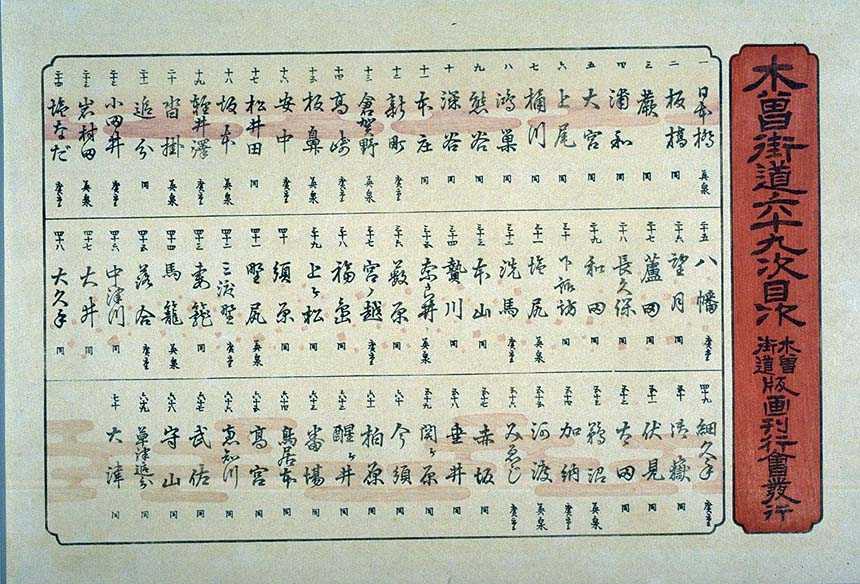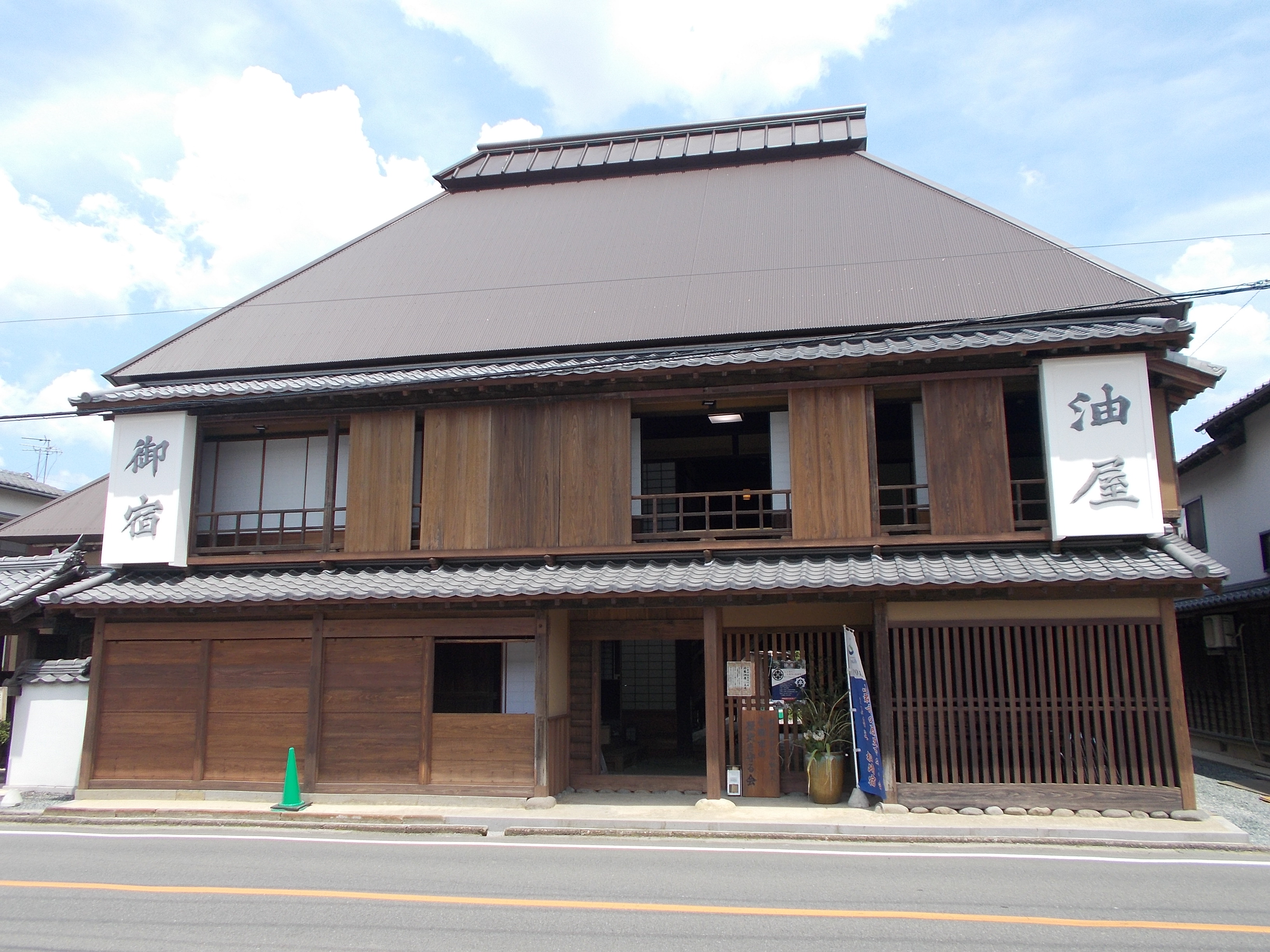|
Unuma-juku
was the fifty-second of the sixty-nine stations of the Nakasendō connecting Edo with Kyoto in Edo period Japan. It is located in former Mino Province in what is now part of the city of Kakamigahara, Gifu Prefecture, Japan.Unuma-juku Juunin Homepage Unuma-juku Juunin. Accessed July 10, 2007. History Unuma was an important junction linking the routes that connected the provinces of Mino and Owari. It is of ancient origin, having been a stop on the old road, that predated the creation of the Nakasendō. It was also the last post station on the[...More Info...] [...Related Items...] OR: [Wikipedia] [Google] [Baidu] |
Kakamigahara, Gifu
is a city located in southern Gifu Prefecture in Japan. , the city had an estimated population of 148,225, and a population density of 1700 persons per km2, in 59,736 households. The total area of the city was . Situated in the northern part of the Nōbi Plain, what is now Kakamigahara originally thrived as a post station on the Nakasendō highway connecting Edo with Kyoto, being called "Unuma-juku" at the time. In more recent history, the city developed due to the JASDF Gifu base. In addition, Kakamigahara grew as an industrial city and a commuter suburb of Gifu City and Nagoya. The city of Kakamigahara has many large parks, the most notable among them being "Kakamigahara Kōen", which was originally made from a vacant lot owned by Gifu University. A city planning policy of making Kakamigahara into a "park city" has been undertaken by the municipality, and in 2005, the city received the Green City Prize from the prime minister. Although the city was officially named Kak ... [...More Info...] [...Related Items...] OR: [Wikipedia] [Google] [Baidu] |
The Sixty-nine Stations Of The Kiso Kaidō
The or ''Sixty-nine Stations of the Kiso Road'', is a series of ''ukiyo-e'' works created by Utagawa Hiroshige and Keisai Eisen. There are 71 total prints in the series (one for each of the 69 post stations and Nihonbashi; Nakatsugawa-juku has two prints). The common name for the Kiso Kaidō is "Nakasendō" so the series is sometimes referred to as the ''Sixty-nine Stations of the Nakasendō''. It is a follow up to Hiroshige's ''The Fifty-three Stations of the Tōkaidō'' and he produced 47 of the prints, with Eisen being responsible for the rest.Hiroshige - Kisokaido www.hiroshige.org.uk. Accessed November 1, 2017. The series was published by Iseya Rihei (Kinjudō) from .Forrer The Naka ...
|
69 Stations Of The Nakasendō
The are the rest areas along the Nakasendō, which ran from Nihonbashi in Edo (modern-day Tokyo) to Sanjō Ōhashi in Kyoto.Yama to Keikoku Publishing (2006). Nakasendō o Aruku (Revised ed.). Osaka: Yama to Keikoku Publishing. .Nakasendō Jōhō . NEC Corporation. Accessed August 18, 2007. The route stretched approximately and was an alternate to the Tōkaidō. 
|
Shinkanō-juku
was a mid-station along the Nakasendō in Edo period Japan. It was in between the post stations of Unuma-juku and Kanō-juku. It is located in the present-day town of Kakamigahara, Gifu Prefecture, Japan. Neighboring post towns ;Nakasendō :Unuma-juku - Shinkanō-shuku - Kanō-juku was the fifty-third of the was the fifty-eighth of the sixty-nine stations of the Nakasendō connecting Edo with Kyoto in Edo period Japan. It is located in former Mino Province in what is now part of the city of Gifu, Gifu Prefecture, Japan. References [...More Info...] [...Related Items...] OR: [Wikipedia] [Google] [Baidu] |
Kanō-juku
was the fifty-third of the was the fifty-eighth of the sixty-nine stations of the Nakasendō connecting Edo with Kyoto in Edo period Japan. It is located in former Mino Province in what is now part of the city of Gifu, Gifu Prefecture, Japan.Nakasendo to Shukuba-machi . Gifu City Hall. Accessed September 9, 2007. /ref> History Kanō-juku is located just south of JR Gifu Station in , and was a |
Honjin
The ''honjin'' at Inaba Kaidō's Ōhara-shuku.">Ōhara-shuku.html" ;"title="Inaba Kaidō's Ōhara-shuku">Inaba Kaidō's Ōhara-shuku. is the Japanese word for an inn for government officials, generally located in post stations (''shukuba'') during the later part of the Edo period. Evolution of ''Honjin'' Originally, ''honjin'' were places from which generals directed battles and, therefore, were fleeting in nature. However, as commanders began to transform the ''honjin'' into temporary lodgings during battle and travel, ''honjin'' came to be places where ''daimyō'' and other representatives of the shogunate, including ''hatamoto'', ''monzeki'', etc., were allowed to stay during their travels. Many of the ''honjin'' were actually personal residences of village and town leaders. As such, they received official designations from the government and expanded their residences to include walls, gates and other features. Because of their cooperation, the owners of the ''honjin'' also ... [...More Info...] [...Related Items...] OR: [Wikipedia] [Google] [Baidu] |
Ai No Shuku
{{nihongo, Ai no Shuku, 間の宿, mid-station were unofficial post stations along historical routes in Japan. These post stations formed organically along routes (such as the Tōkaidō and the Nakasendō) when the distance between two places was too far or when there were difficult passes nearby. Because they were not officially designated rest areas, travelers along the roads were not allowed to stay in these post stations. Sometimes the Japanese is shortened to 間宿. Notable ''ai no shuku'' Tōkaidō :*Ninomiya-shuku (二宮宿) (between Ōiso-juku and Odawara-juku) ( Ninomiya, Kanagawa Prefecture) :*Hatake-shuku (畑宿) (between Odawara-juku and Hakone-juku) (Hakone, Kanagawa Prefecture) :*Iwabuchi-shuku (岩淵宿) (between Yoshiwara-juku and Kanbara-juku) ( Fujikawa, Shizuoka Prefecture) :*Kikugawa-shuku (菊川宿) (between Kanaya-juku and Nissaka-shuku) ( Shimada, Shizuoka Prefecture) :*Moto-juku (本宿) (between Akasaka-juku and Fujikawa-shuku) ( Okazaki, Aichi Pre ... [...More Info...] [...Related Items...] OR: [Wikipedia] [Google] [Baidu] |
Ōta-juku
was the fifty-first of the sixty-nine stations of the Nakasendō connecting Edo with Kyoto in Edo period Japan. It is located in former Mino Province in what is now part of the city of Minokamo, Gifu Prefecture, Japan.Nakasendō no Ōta-juku Nakasendō Museum OOTAJUKU.NET. Accessed June 5, 2008. History Ōta is located at the confluence of the and the , and the river crossing at this location was considered the most difficult on the Nakasendō. During the spring thaw, flooding was common, and the Hida River could be enlarged to over 700 meters i ...[...More Info...] [...Related Items...] OR: [Wikipedia] [Google] [Baidu] |
Sake
Sake, also spelled saké ( ; also referred to as Japanese rice wine), is an alcoholic beverage of Japanese origin made by fermenting rice that has been polished to remove the bran. Despite the name ''Japanese rice wine'', sake, and indeed any East Asian rice wine (such as huangjiu and cheongju), is produced by a brewing process more akin to that of beer, where starch is converted into sugars which ferment into alcohol, whereas in wine, alcohol is produced by fermenting sugar that is naturally present in fruit, typically grapes. The brewing process for sake differs from the process for beer, where the conversion from starch to sugar and then from sugar to alcohol occurs in two distinct steps. Like other rice wines, when sake is brewed, these conversions occur simultaneously. The alcohol content differs between sake, wine, and beer; while most beer contains 3–9% ABV, wine generally contains 9–16% ABV, and undiluted sake contains 18–20% ABV (although this is often ... [...More Info...] [...Related Items...] OR: [Wikipedia] [Google] [Baidu] |
Hatago
were Edo period lodgings for travelers at '' shukuba'' (post stations) along the national highways, including the Edo Five Routes The , sometimes translated as "Five Highways", were the five centrally administered routes, or ''kaidō'', that connected the ''de facto'' capital of Japan at Edo (now Tokyo) with the outer provinces during the Edo period (1603–1868). The most ... and the subroutes. In addition to a place to rest, ''hatago'' also offered meals and other foods to the travelers. They were also called . Name origin ''Hatago'' means "traveling basket." The word itself originally derived from baskets that contained food for horses and were carried by travelers. From there, it became a tool with which travelers were carry their own food and goods. Shops that began preparing and selling food for travelers gained the suffix , meaning "shop," but this was eventually shortened to just ''hatago''. Preserved ''hatago'' Because many post stations along the Tōkaidō, Nakas ... [...More Info...] [...Related Items...] OR: [Wikipedia] [Google] [Baidu] |
Machiya
are traditional wooden townhouses found throughout Japan and typified in the historical capital of Kyoto. (townhouses) and (farm dwellings) constitute the two categories of Japanese vernacular architecture known as (folk dwellings). originated as early as the Heian period and continued to develop through to the Edo period and even into the Meiji period. housed urban merchants and artisan, craftsmen, a class collectively referred to as (townspeople). The word is written using two kanji: meaning "town", and meaning "house" () or "shop" () depending on the kanji used to express it. in Kyoto, sometimes called , formed the defining characteristic of downtown Kyoto architecture for centuries,Kyoto Center for Community Collaboration (京都市景観・まちづくりセンター)(eds.) ''Machiya Revival in Kyoto'' (京町家の再生). Kyoto: Kyoto Center for Community Collaboration, 2008. p10. representing the standard defining form of the throughout the country. Th ... [...More Info...] [...Related Items...] OR: [Wikipedia] [Google] [Baidu] |
Shukuba
were post stations during the Edo period in Japan, generally located on one of the Edo Five Routes or one of its sub-routes. They were also called ''shuku-eki'' (宿駅). These post stations (or "post towns") were places where travelers could rest on their journey around the nation. They were created based on policies for the transportation of goods by horseback that were developed during the Nara and Heian periods. History These post stations were first established by Tokugawa Ieyasu shortly after the end of the Battle of Sekigahara. The first post stations were developed along the Tōkaidō (followed by stations on the Nakasendō and other routes). In 1601, the first of the Tōkaidō's fifty-three stations were developed, stretching from Shinagawa-juku in Edo to Ōtsu-juku in Ōmi Province. Not all the post stations were built at the same time, however, as the last one was built in 1624. The lodgings in the post stations were established for use by public officials and, ... [...More Info...] [...Related Items...] OR: [Wikipedia] [Google] [Baidu] |





.jpg)